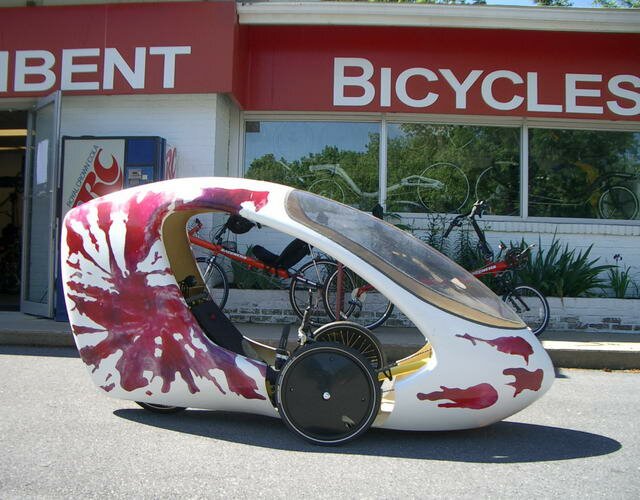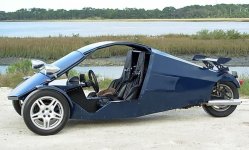You are using an out of date browser. It may not display this or other websites correctly.
You should upgrade or use an alternative browser.
You should upgrade or use an alternative browser.
Enclosed trike / Velomobile dream
- Thread starter swbluto
- Start date
MitchJi
10 MW
Hi,
http://www.unisa.edu.au/solarcar/Trev/


Building an ultra light-weight car, Part 2
AND:
Want to build your own Trev? Find out how atTREVipedia.
http://www.unisa.edu.au/solarcar/Trev/

Building an ultra light-weight car, Part 1Suppose you decided that you weren't going to use fossil fuels anymore. How would you get around?
Solar racing cars are able to travel 750 km per day, at highway speeds, powered only by sunlight. Surely it is possible to use similar technologies to build a car in which you could do your daily commuting, but without the noise and pollution of a petrol engine.
Staff and students at the University of South Australia have designed and built such a carâ€â€Trev. Its features include:
* two comfortable seats, since more than 90% of urban trips have only one or two people in the car;
* enough luggage space for at least two overnight bags;
* 300 kg massâ€â€because using a 2.5 tonne vehicle for commuting is ridiculous;
* energy-efficient tyres, brakes and suspension;
* a clean, quiet and efficient electric drive system;
* compliance with road safety and worthiness regulations;
* good performance, with a top speed of 120 km/h; and
* 150 km of city driving before the car must be recharged.
Most importantly, it uses less than 1/5 of the energy required by a conventional car, and can be recharged using electricity from clean, renewable sources such as solar and wind.
And it doesn't look too bad...
Features
* The tandem seating layout gives good aerodynamics, good balance, and good vision.
* The acrylic canopy gives the driver an unimpeded view of the road.
* The canopy and door open on the kerb side of the car.
* The electric motor gives smooth, quiet acceleration from 0–100 km/h in under 10 seconds.
* A composite tub chassis, with foam and plastic body panels, gives a total car mass of 300 kg.
* A 45 kg lithium ion polymer battery gives over 150km of city driving.
* Low-energy tyres on low-mass alloy wheels give low rolling resistance.
* The single rear drive wheel simplifies the suspension, and allows a simple, efficient transmission.
Performance
In October 2007 we drove Trev from Darwin to Adelaide in the Greenfleet Technology Class of the World Solar Challenge. For most of the journey, we drove 80 - 120 km at speeds of 80 - 90 km/h before stopping to recharge from a generator. We completed the 3020 km trip in just over 6 days.
Our energy consumption was 6.2 kWh/100 km. Recharged from solar, wind or hydro, there are no emissions.
Electricity costs about $0.18 per kWh. The cost of recharging Trev is 1.1 cents per kilometre, so the entire journey cost us $33 of electricity
It makes petrol look silly.
For more information, see our Q and A about Trev. We also have images and movies.
AutoSpeed has written a couple of good articles on how we built Trev:
The University of South Australia thinks there is. They’ve built a very interesting ultra-lightweight, two-seat, electric-powered car, using a constructional approach that is relatively cheap, straightforward, and utilises off-the-shelf materials. It’s also strong. Furthermore, the external shape of the car can be produced without the need for moulds, or panel-beating or pressing metal panels to shape.
The construction makes use of lightweight composite fibreglass and aluminium honeycomb panels, fibreglass cloth, Kevlar cloth, a small amount of carbon fibre cloth, epoxy resin and expanded polystyrene.
It’s a vehicle building technique that could literally be done in your home workshop with just hand tools.
We’ll cover the mechanical details of the car in a later article, but let’s look now at how they made the vehicle monocoque tub. It’s a process that opens up enormous possibilities in DIY cars across a range of efficient vehicle types – from human-powered, to electric-powered, to road machines with ultra-efficient internal combustion engines.

Building an ultra light-weight car, Part 2
AND:
Want to build your own Trev? Find out how atTREVipedia.
Wow, very interesting MitchJi!
The 300 kg mass looks like a bit much, but I suspect most of that is due to the "car-like" design? Doesn't seem to lend itself well to solar propulsion, but it seems that it's possible to pedal at least a third of the energy required at speed.
The 300 kg mass looks like a bit much, but I suspect most of that is due to the "car-like" design? Doesn't seem to lend itself well to solar propulsion, but it seems that it's possible to pedal at least a third of the energy required at speed.
Nice images above.
This is a build belonging to a person I chat with on the IRC channel ##clean-energy from the irc.freenode.net network. We discuss solar power and other alternative energy, such as at home methanol from CO2 and H2 and a few of us have EV projects there.

You can find more about it by clicking the link below.
http://www.zev.dk/specs.htm
This is a build belonging to a person I chat with on the IRC channel ##clean-energy from the irc.freenode.net network. We discuss solar power and other alternative energy, such as at home methanol from CO2 and H2 and a few of us have EV projects there.

You can find more about it by clicking the link below.
http://www.zev.dk/specs.htm
docnjoj
1 GW
jmygann said:But are there any pedal/electric semi-enclosed Tadpole Trikes that have more upright seating ?
A "legal" (750-1000 watt assist) tadpole trike with comfortable partial enclosure. ?? for daily commuting year round
Yeah, but they are not cheep! These are about 9 grand without electrics.
otherDoc
http://www.velomobiles.net/wildfire/index.htm
www.recumbents.com
10 kW
Maybe something like this?
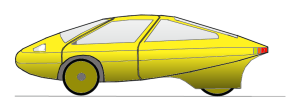
http://www.recumbents.com/wisil/e-bent/TandemE-Trike.htm
I have been contemplating this for some time as a human/electric hybrid. Because it would be two people wide, I'm thinking now that it would need to go at least 45MPH on electric, which would mean it would need to be registered as a motorcycle. Using something like the new Kelly 6KW hub on the rear would be a good option, but I'm not sure how to keep the human powered portion of it with that hub. Maybe just need to modify the disk brake to add a bike chain cog... Using a scavenged motorcycle rear subframe and maybe an 4 wheeler ATV front suspension would really help to simplify the design. Does anyone know of a cheap delta trike motorcycle that could be used as a donor? That would make licensing it easier too.
-Warren.

http://www.recumbents.com/wisil/e-bent/TandemE-Trike.htm
I have been contemplating this for some time as a human/electric hybrid. Because it would be two people wide, I'm thinking now that it would need to go at least 45MPH on electric, which would mean it would need to be registered as a motorcycle. Using something like the new Kelly 6KW hub on the rear would be a good option, but I'm not sure how to keep the human powered portion of it with that hub. Maybe just need to modify the disk brake to add a bike chain cog... Using a scavenged motorcycle rear subframe and maybe an 4 wheeler ATV front suspension would really help to simplify the design. Does anyone know of a cheap delta trike motorcycle that could be used as a donor? That would make licensing it easier too.
-Warren.
MitchJi
10 MW
Hi,
It was built as a replacement for an automobile. For a two passenger automobile 300kg is extremely light. I think some of the techniques they use could be used to build a smaller lighter Velomobile.
Warren:
That will use so little electricity (Justin crossed Canada for under $9) that I think the main benefit to pedaling that at 45mph will be fitness. A simpler (and admittedly less efficient way to do that would be to pedal a generator that charges your pack.
For motorcycle registration you need to find out the requirements in your state. Using an ATV as a donor is probably doable. Maybe my earlier post in a different thread onregistering an ATV as a motorcycle in CA will give you some ideas:
http://endless-sphere.com/forums/posting.php?mode=quote&f=28&p=199808
SW:swbluto said:Wow, very interesting MitchJi!
The 300 kg mass looks like a bit much, but I suspect most of that is due to the "car-like" design? Doesn't seem to lend itself well to solar propulsion, but it seems that it's possible to pedal at least a third of the energy required at speed.
It was built as a replacement for an automobile. For a two passenger automobile 300kg is extremely light. I think some of the techniques they use could be used to build a smaller lighter Velomobile.
www.recumbents.com said:I'm thinking now that it would need to go at least 45MPH on electric, which would mean it would need to be registered as a motorcycle. Using something like the new Kelly 6KW hub on the rear would be a good option, but I'm not sure how to keep the human powered portion of it with that hub. Maybe just need to modify the disk brake to add a bike chain cog... Using a scavenged motorcycle rear subframe and maybe an 4 wheeler ATV front suspension would really help to simplify the design... That would make licensing it easier too.
-Warren.
Warren:
That will use so little electricity (Justin crossed Canada for under $9) that I think the main benefit to pedaling that at 45mph will be fitness. A simpler (and admittedly less efficient way to do that would be to pedal a generator that charges your pack.
For motorcycle registration you need to find out the requirements in your state. Using an ATV as a donor is probably doable. Maybe my earlier post in a different thread onregistering an ATV as a motorcycle in CA will give you some ideas:
http://endless-sphere.com/forums/posting.php?mode=quote&f=28&p=199808
MitchJi said:... There was a company in CA that was planning to convert 3 wheel ATV's to street legal by registering them as motorcycles . A little while later the state of CA made it virtually impossible to make ATV's street legal due to air pollution issues but etrikes would probably be doable.
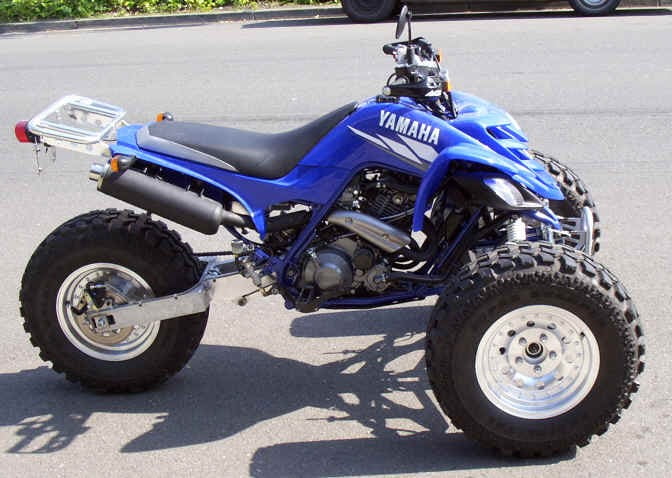

How do I obtain a license plate for my ATV?
There are a number of ways to obtain a license plate for an ATV in the state of California. If you own or operate an agricultural business, you may acquire a license plate with four wheels and the addition of safety lighting as outlined by the California Highway Patrol. There are restrictions for operation with this type of license, please check with the DMV and the CHP for details. Ask for CHP forms 885 and 892 which have the detailed requirements for automobiles.
For those that wish not to have the agricultural restrictions or do not qualify, you are left with a decision to comply with automotive or motorcycle requirements. Automotive requirements include 5 mph bumpers, safety restraint system and safety glass windshield among other things that make it impractical to choose this path with an ATV.
If you choose the motorcycle path, you must alter the ATV to fit the description of 3 wheels or less in contact with the ground. This is a link to the CHP website that outlines some of the requirements. You will also need to have a copy of form CHP 888, which outlines the specific requirements and will be available at this site in the near future.
Where can I find ... ?
All lighting and tires need to be DOT approved. There are many sources for DOT approved lighting available either from your local motorcycle shop or the internet. The Raptor's lights were acquired from Baja designs, knowledgeable and easy to work with. Check them out at http://www.bajadesigns.com/ .
CA DMV:
What is a motorcycle?
A motorcycle is a vehicle whose motor displaces more than 150 cubic centimeters and has a seat or saddle for the use of the rider. It is designed to travel on not more than three wheels in contact with the ground and weighs less than 1,500 pounds.
A motor-driven cycle is a motorcycle whose motor displaces less than 150 cubic centimeters.
jmygann
100 kW
- Joined
- May 30, 2008
- Messages
- 1,069
warren ...
i would still lke to see the side by side 2 seater happen.
My favorite shape ...the Tango

http://www.gekgo.com/3-wheel_gas_scooter_%20trikes.html
just add pedals
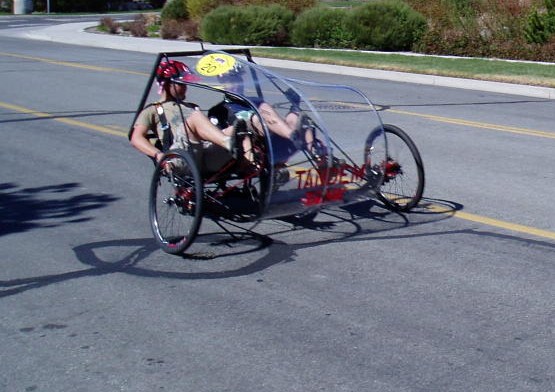
keep it under 1000 watts and don't get caught going over 20mph and no registration needed
i would still lke to see the side by side 2 seater happen.
My favorite shape ...the Tango

http://www.gekgo.com/3-wheel_gas_scooter_%20trikes.html
just add pedals

keep it under 1000 watts and don't get caught going over 20mph and no registration needed
www.recumbents.com said:Maybe something like this?

http://www.recumbents.com/wisil/e-bent/TandemE-Trike.htm
I have been contemplating this for some time as a human/electric hybrid. Because it would be two people wide, I'm thinking now that it would need to go at least 45MPH on electric, which would mean it would need to be registered as a motorcycle. Using something like the new Kelly 6KW hub on the rear would be a good option, but I'm not sure how to keep the human powered portion of it with that hub. Maybe just need to modify the disk brake to add a bike chain cog... Using a scavenged motorcycle rear subframe and maybe an 4 wheeler ATV front suspension would really help to simplify the design. Does anyone know of a cheap delta trike motorcycle that could be used as a donor? That would make licensing it easier too.
-Warren.
www.recumbents.com
10 kW
jmygann
100 kW
- Joined
- May 30, 2008
- Messages
- 1,069
i like the shape and roll cage .... are we still talking pedal tricycle ?
A elec. assisted tadpole pedal trike with similar shape is my vote
Also there is the Bug E ... just add pedals
http://www.youtube.com/watch?v=MKoi9aQO6Co&feature=related
and Mercedes
http://www.youtube.com/watch?v=uN3You1UUoI&feature=related
and Drymer
http://www.youtube.com/watch?v=1Q8p2q0p4rc&feature=related
and Sam
http://www.youtube.com/watch?v=fPkM61hhYzc&feature=related
and Sparrow
http://www.youtube.com/watch?v=Qw7WXwiIyIU&feature=related
But for a pedal machine you need to move the driver/peddler forward with knees near the front wheels
as in the Go One
http://www.youtube.com/watch?v=2JwEHN0eOK0
Or Leitra
http://www.youtube.com/watch?v=2BPLeQ3rTIU
A elec. assisted tadpole pedal trike with similar shape is my vote
Also there is the Bug E ... just add pedals
http://www.youtube.com/watch?v=MKoi9aQO6Co&feature=related
and Mercedes
http://www.youtube.com/watch?v=uN3You1UUoI&feature=related
and Drymer
http://www.youtube.com/watch?v=1Q8p2q0p4rc&feature=related
and Sam
http://www.youtube.com/watch?v=fPkM61hhYzc&feature=related
and Sparrow
http://www.youtube.com/watch?v=Qw7WXwiIyIU&feature=related
But for a pedal machine you need to move the driver/peddler forward with knees near the front wheels
as in the Go One
http://www.youtube.com/watch?v=2JwEHN0eOK0
Or Leitra
http://www.youtube.com/watch?v=2BPLeQ3rTIU
michaelplogue
10 kW
I'm surprised nobody has suggested a flexible, fabric skin velomobile body - like the concept BMW GINA. You wouldn't necessarily need to have it capable of changing shape, but a simple fiberglass, CF, or aluminum rod framework with a durable lycra-like fabric would make a simple and aerodynamic body. If one wanted a more permanent solution, one could simply give it a couple of good layers of spray epoxy.
[youtube]BNGlaj7BDSM[/youtube]
[youtube]BNGlaj7BDSM[/youtube]
docnjoj
1 GW
As usual, Michael, it is already done.
http://www.velokit.com/
otherDoc
http://www.velokit.com/
otherDoc
michaelplogue
10 kW
OK... I'll give you that one - the concept is somewhat similar. However, the execution is miles apart, and the VeloKit lacks quite a lot of sex appeal..........  :wink:
:wink:
Which velo-skin would you prefer to wear?
This...........?


........ Or something made like this ......?

Which velo-skin would you prefer to wear?
This...........?


........ Or something made like this ......?

SpeedEBikes
100 W
Here's my electric assist fulls suspension tadpole & trailer with a little weather protection, 1000 lb max payload capacity and seating for two passengers. Looked into doing solar roof panels but don't yet believe it very cost effective or practical. However, it is easy to find power in an urban environment so I just carry a tiny 350 watt charger and plug in when I must.
michaelplogue
10 kW
jmygann said:If there is to be some new directions it needs to be economically viable not just keyboard chatter and unrealistic dreams
Huh?
jmygann
100 kW
- Joined
- May 30, 2008
- Messages
- 1,069
Maybe a light weight roll cage frame that would incorporate a light weight roof and front aero ?? but still be easy to get in and out of ??
Also some roll over protection and side impact
might look like this but for a tadpole ... http://goblinmotors.com/html/goblinaero_high_mpg_vehicle__c.html
Also some roll over protection and side impact
might look like this but for a tadpole ... http://goblinmotors.com/html/goblinaero_high_mpg_vehicle__c.html
docnjoj
1 GW
Well, Michael, that little Bimmer logo means unobtanium. The Velo is about 750 USD. It ain't very pretty but does do the job. In fact, I would consider it if I had to commute in cold weather. I don't! It is light weight and keeps the rain off and the wind from slowing one down as much. Seems like a fair tradeoff for ugly!
otherDoc
otherDoc
John in CR
100 TW
Doc,
It's pretty all right...pretty f'ing ugly! Looks like horrible aero too.
Here's a method I've been toying with for building a super light, easily repairable, and aerodynamic faring. If a seaworthy canoe can weigh 8lbs, imagine how light a no load bearing structure could be, since most of the canoe's weight is in the framing. http://www.gaboats.com
John
It's pretty all right...pretty f'ing ugly! Looks like horrible aero too.
Here's a method I've been toying with for building a super light, easily repairable, and aerodynamic faring. If a seaworthy canoe can weigh 8lbs, imagine how light a no load bearing structure could be, since most of the canoe's weight is in the framing. http://www.gaboats.com
John
docnjoj
1 GW
John in CR said:Doc,
It's pretty all right...pretty f'ing ugly! Looks like horrible aero too.
Here's a method I've been toying with for building a super light, easily repairable, and aerodynamic faring. If a seaworthy canoe can weigh 8lbs, imagine how light a no load bearing structure could be, since most of the canoe's weight is in the framing. http://www.gaboats.com
John
Wow, John! Great minds do think alike! I saw that website a while ago and it reminded me of my Cleveland Model kits that I used to build. I'm way short on patience for that kind of thing now, but it sure is eiegant and light! Way kool! You have the same problem that I do regarding heat. I could only use a fairing or enclosure a few weeks of the year. It is to dam* hot!
otherDoc
Malcolm
10 kW
I finally remembered what that BMW concept reminded me of – the Velorex Oscar: http://microcarmuseum.com/tour/velorex.html
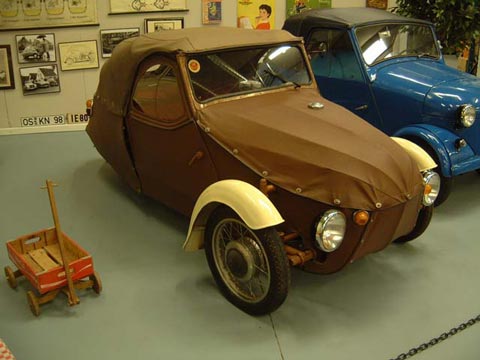

deardancer3
10 kW
http://www.cambiecycles.com/velo.html
$5500 Canadian, Vancouver, with e-assist
$5500 Canadian, Vancouver, with e-assist
docnjoj
1 GW
Wow Dick! That Aurora is a great deal with the BionX attached. I wish I needed one!
otherDoc
otherDoc
Similar threads
- Replies
- 8
- Views
- 689
- Replies
- 27
- Views
- 839
- Replies
- 7
- Views
- 343
- Replies
- 3
- Views
- 770
- Replies
- 108
- Views
- 12,709


